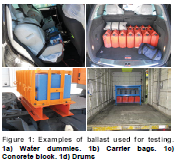EVU XXIII 2014-16 The development of standardized safety requirements for ballast-fastening devices in testing trucks
Adrià Ferrer, Alberto Martínez, Jaume Compte
Applus+ IDIADA
Abstract
 Among the many types of tests carried out at testing facilities, several involve goods vehicles.
Among the many types of tests carried out at testing facilities, several involve goods vehicles.
These vehicles are usually loaded with concrete blocks as ballast in order to simulate a real load or to increase the stability of the whole vehicle.
However, these concrete blocks are not locked to the chassis and therefore a weak fastening might present safety problems in case of collision or hard braking manoeuvres. Thus, the fastening of the ballast must guarantee a minimum level of resistance. In order to establish a safe standardized fastening device, a study was performed using crash testing data as a base to validate a device through simulation and sled testing.
Based on data from a truck bollard test and PC-Crash® simulations, two fixing devices were assessed through sled tests. The first system consisted of two towropes hooked to the chassis of the vehicle. The second system was a metal structure consisting of two bars placed around the load and fixed to the chassis. A concrete block of 500 kg was placed on a structure especially developed to simulate the vehicle chassis. The test performed was based on a deceleration corridor previously defined and representative of a potential risk situation.
After the tests, the fixing device which performed best was defined in a CAE simulation to establish a minimum set of requirements, which will enable clients to use their own fixing device, but following the established requirements.
Testo completo della pubblicazione scientifica disponibile ai soli iscritti.
| Autore | Adrià Ferrer, Alberto Martínez, Jaume Compte Applus+ IDIADA |
| Pubblicato il | |
| Tipologia |
